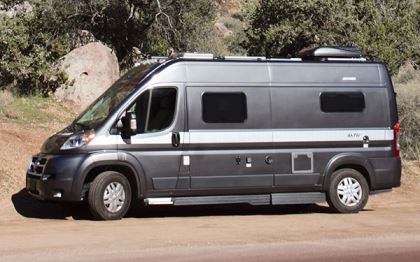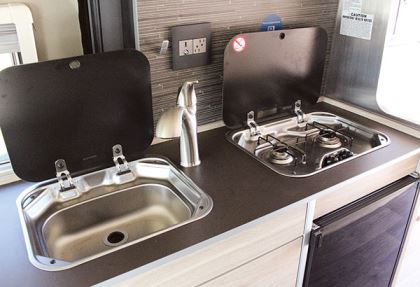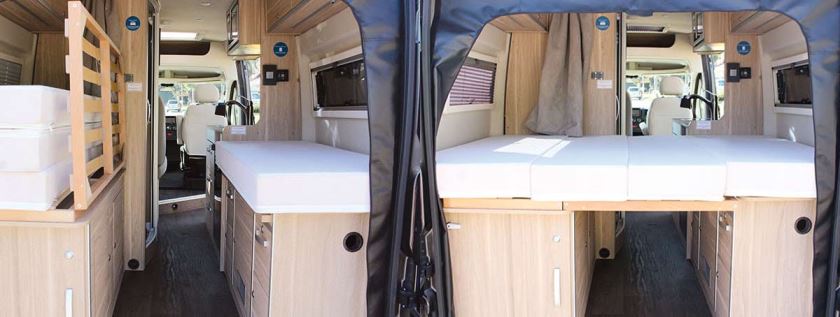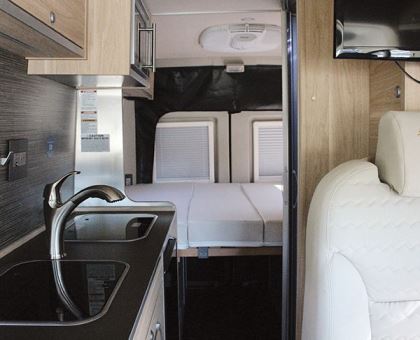By Lazelle Jones
German RV manufacturer Erwin Hymer Group has been building recreation vehicles in Europe since 1956. In February 2016 the company acquired Canadian Type B motorhome manufacturer Roadtrek Motorhomes Inc., which led to the formation of Erwin Hymer Group North America Inc. (EHGNA). Not long after the acquisition, EHGNA introduced a Type B motorhome under the Hymer brand, the Aktiv, which is the subject of this review.
 As its name implies, the Aktiv was created for those who enjoy an “active” lifestyle. Other design criteria included respectable fuel economy; driving ease and maneuverability, even in urban settings; and ample power and responsiveness. The Aktiv’s compact size enables it to be driven just about anywhere. Yet, when
As its name implies, the Aktiv was created for those who enjoy an “active” lifestyle. Other design criteria included respectable fuel economy; driving ease and maneuverability, even in urban settings; and ample power and responsiveness. The Aktiv’s compact size enables it to be driven just about anywhere. Yet, when
designing the coach, Hymer personnel also wanted it to provide creature comforts associated with the luxury RV lifestyle. Finally, EHGNA officials wanted this motorhome to be offered at a retail price point that fits the “family budget.”
I was eager to see what the new Aktiv offers the motorhome enthusiast. After waiting “in line” several months for a preview opportunity, I took temporary possession of a unit in February 2017. What followed were several days of primitive camping in Utah, and 1,200 miles of driving across a wide variety of road scenarios (I avoided snow and ice-covered roads, however).
EHGNA designers elected to build the Aktiv on the Ram ProMaster chassis. Featuring unibody construction, this front-wheel-drive platform is powered by a 3.6-liter V-6 fuel-injected gasoline engine that sits transverse above the two front wheels. The engine is coupled to a six-speed electronic automatic transmission with tow mode.
The Ram ProMaster is rated to tow 4,112 pounds and comes with a Class 5 receiver hitch and 4-pin and 7-pin electrical couplings. The gross vehicle weight rating (GVWR) is 9,350 pounds. My test unit had an actual gross weight of 7,600 pounds. This included a half tank of fuel (tank capacity is 24 gallons) and a full fresh-water tank (30 gallons). The front axle and rear axle gross weights were 3,680 pounds and 3,640 pounds, respectively.
Systems, Interior
Now, the Aktiv incorporates a feature that has been around in Europe for some time but has not been used much in North America: a removable cassette for the marine-style toilet. The cassette is housed in an outside driver’s-side compartment. So, when the cassette is full, the RV owner removes it and carries it — like a small suitcase — to a point of disposal in order to dump the waste. The cassette holds 4.6 gallons and is treated with the customary holding tank chemicals.
 The Aktiv’s 23-gallon gray-water tank is dumped by gravity. The fresh-water tank holds 30 gallons.
The Aktiv’s 23-gallon gray-water tank is dumped by gravity. The fresh-water tank holds 30 gallons.
Another feature in the test coach that departs from conventional North American motorhome design is the lack of a traditional auxiliary generator. The electrical heart and soul of the test unit are two large lithium house batteries. These EcoTrek lithium batteries are optional; otherwise, the coach comes standard with two 6-volt AGM batteries and a 280-amp 12-volt under-hood generator.
Everything on the motorhome, whether operated by 12-volt DC or 120-volt AC, uses these maintenance-free batteries as its power supply. The chassis has its own 12-volt lead-acid battery.
The house batteries can be charged from four power sources. One is the engine as the unit motors down the road. A second is 30-amp shore power when the motorhome is hooked up at a campsite. Source three is the optional roof-mounted solar panels that yield 250 watts of charge. The fourth source is the optional VoltStart battery management system, a combination remote and automatic starter for the coach. The VoltStart system automatically starts the engine to recharge the batteries when they get down to a certain threshold. This takes the worry out of managing battery levels.
A 2,000-watt inverter draws 12-volt-DC power from the coach battery pack and converts it to 120-volt-AC power that is delivered to twelve 120-volt outlets throughout the coach interior, plus one outside in the patio area. The inverter also powers an 11,000-Btu roof air conditioner.
The 3.1-cubic-foot electric refrigerator uses only DC power, as do the interior lighting system, the house water pump, and the blower on the 14,300-Btu forced-air furnace. Throughout the interior, USB ports to charge digital handheld devices are strategically located.
 So, without a traditional auxiliary generator, how are the Aktiv’s dual lithium batteries charged if you are enjoying primitive camping and the roof-mounted solar panels cannot keep up with the discharge of these batteries? A second serpentine belt-driven alternator (280 amps) is mounted to the engine. When the battery discharge reaches a designated level, you simply reach for the ignition key and start the engine. This auxiliary alternator quickly brings the house batteries back to the level of charge required to operate everything inside the cabin. The 3.6-liter engine sips fuel as it idles and can be turned off when the need for the auxiliary engine-driven alternator subsides. Without a propane or gasoline auxiliary generator, coach weight is reduced. The initial expense of the generator and its ongoing maintenance are eliminated as well. This also allows the 5.9-gallon propane tank to be reserved for supplying the furnace and the two-burner cooktop.
So, without a traditional auxiliary generator, how are the Aktiv’s dual lithium batteries charged if you are enjoying primitive camping and the roof-mounted solar panels cannot keep up with the discharge of these batteries? A second serpentine belt-driven alternator (280 amps) is mounted to the engine. When the battery discharge reaches a designated level, you simply reach for the ignition key and start the engine. This auxiliary alternator quickly brings the house batteries back to the level of charge required to operate everything inside the cabin. The 3.6-liter engine sips fuel as it idles and can be turned off when the need for the auxiliary engine-driven alternator subsides. Without a propane or gasoline auxiliary generator, coach weight is reduced. The initial expense of the generator and its ongoing maintenance are eliminated as well. This also allows the 5.9-gallon propane tank to be reserved for supplying the furnace and the two-burner cooktop.
Another noteworthy cabin feature is the central heating system. EHGNA does not rate the Aktiv as a four-season coach, so it’s uncertain how it would do when camping in severely cold temperatures. One thing to consider is that the holding tanks are not heated. When we were at Bryce Canyon, however, the nighttime temperature dipped to 17 degrees, and we were just fine.
What EHGNA has done with the central heating system design is also a departure from conventional coach design. The cabin features dual heat sources that you can select or mix. The system incorporates an electric heater powered by the house batteries as well as a conventional 14,300-Btu propane furnace. At the control panel you can choose electric, propane furnace, or a combination of the two.
 To help insulate the motorhome interior during cold-weather camping, accordion-style blackout shades over each window can be drawn closed, creating an additional thermal barrier (thin layer of air) to help slow down the transfer or loss of heat through the windows. I also imagine that these shades would help the air conditioner cool the interior during hot and humid times. A large, hinged skylight in the forward end of the cabin (which can be raised to create airflow) also has a blackout accordion shade. Similar shades can be pulled across the windshield.
To help insulate the motorhome interior during cold-weather camping, accordion-style blackout shades over each window can be drawn closed, creating an additional thermal barrier (thin layer of air) to help slow down the transfer or loss of heat through the windows. I also imagine that these shades would help the air conditioner cool the interior during hot and humid times. A large, hinged skylight in the forward end of the cabin (which can be raised to create airflow) also has a blackout accordion shade. Similar shades can be pulled across the windshield.
The Aktiv seats four via the driver and copilot chairs in the cockpit, and a two-passenger seat directly behind them. A table that folds against the street-side wall, forward of the rear seat, can accommodate four when the captains chairs are turned rearward. The Aktiv can sleep up to four: two on the rear fold-down queen-size bed, and two at the front of the coach when utilizing the second-row seat and optional folding mattress.
The Aktiv’s residential features work nicely for two adults. Living quarters are close in this Type B motorhome. Having said that, a shift in lifestyle makes this smaller, more efficient unit quite functional, and it will appeal to the many motorhome enthusiasts who are looking for exactly that.
At the galley you can stand in one place and execute all the motions needed to be a full-on chef. The 3.1-cubic-foot refrigerator (with a freezer compartment) sits directly below the galley counter. The two-burner recessed cooktop comes with a fold-up glass cover. The single-tub galley sink next to it features a similar glass cover. With both covers closed, a large, flat countertop is created. A 0.7-cubic-foot microwave is included in the galley as well.
Large, deep drawers from floor to countertop are more than respectable in size. They are opened and closed by the push-pull latches used throughout the coach. Push the knob and the drawer locks shut. Touch and release the knob and it becomes the handle for pulling the drawer or cabinet door open. The drawers are equipped with soft-close mechanisms. You need only to get the drawer within an inch of closure and the mechanism completes the job.
Also, the Aktiv’s full-service wet bath has its own permanent location on the street side, midway in the unit. The bathroom is compact but has been well thought through. It features an ergonomic swivel toilet and a fold-down sink with a faucet that pulls out to become the showerhead. The accordion-style door slides open or closed; the shower curtain pulls across to shed water to the floor drain when the shower is being used.
A sliding side entry door and two swing-out rear doors with screens provide easy access to coach contents, plus ventilation.
Because the Ram ProMaster does not have a front-to-rear driveshaft, Hymer maximized the Aktiv’s interior height by creating a step down from the cockpit; this increases ceiling height by approximately 6 inches. Those moving about inside the motorhome will want to be aware of this.
On The Road
Next, o![]() ver the 1,200 miles I traveled, fuel economy varied depending on the operating conditions. For example, on the freeway in stop-and-go morning traffic, fuel economy averaged 13 mpg. On Utah back roads, where meandering at moderate speeds permitted me to soak in the view, the Aktiv averaged 19 mpg.
ver the 1,200 miles I traveled, fuel economy varied depending on the operating conditions. For example, on the freeway in stop-and-go morning traffic, fuel economy averaged 13 mpg. On Utah back roads, where meandering at moderate speeds permitted me to soak in the view, the Aktiv averaged 19 mpg.
It took little effort to charge along on the interstate at speeds of 75 mph. In addition, the coach was stable when we encountered strong, buffeting winds through the Virgin River Gorge between Las Vegas and sites in southern Utah.
The driver becomes familiar with the ProMaster’s user-friendly cockpit in a minimal amount of time. Conventional layout of controls and instrumentation made for ease of operation. Those inside the cockpit almost forget that this is a full-service motorhome, not simply a van. Telescopic steering, a rearview camera, and GPS helped to make travel time smooth.
Next, visibility out the front and along both sides of the unit presented no unusual challenges. My only critique here involved the rear camera, which feeds visuals to the dash-mounted monitor when the transmission is in reverse. The monitor took several seconds to come online, which delayed backing (for safety reasons). In most cases, parking this 19-foot-7-inch motorhome around other full-size vehicles was accomplished with relative ease.
The base manufacturer’s suggested retail price of the 2017 Hymer Aktiv is $92,814. The optional equipment on the model I reviewed included the EcoTrek 400 lithium power module, 250-watt solar panels, and the VoltStart auto-start system. As tested, the MSRP came to $102,853.
Lastly, RVers who enjoy the journey but want easy access to hiking, fishing, and other sports and hobbies may consider the Hymer Aktiv to be a great choice. Plus, with its generous six-year warranty, it should offer many years of travel freedom.
![]()
SPECS
MANUFACTURER
Erwin Hymer Group North America Inc., 100 Shirley Ave., Kitchener, ON Canada N2B 2E1; (844) 464-9637; www.gohymer.com
MODEL
Hymer Aktiv
FLOOR PLAN
Aktiv
SLIDEOUTS
N/A
CHASSIS
Ram ProMaster 2500 Regular Van
ENGINE
3.6-liter V-6, 24-valve;
280 horsepower
TRANSMISSION
automatic six-speed TE
AXLE RATIO
3.86 to 1
TIRES
LT225/75R16E black wall
WHEELS
16-inch polished aluminum
WHEELBASE
159 inches
BRAKES
antilock (ABS) four-wheel disc
SUSPENSION
front — independent MacPherson struts with stabilizer bar;
rear — solid axle with leaf spring
SHOCK ABSORBERS
MacPherson struts
STEERING
telescopic
ALTERNATOR
220 amps
BATTERIES
house — (2) 6-volt AGM, standard); (2) optional EcoTrek lithium, as on test coach;
chassis — (1) 800 amps
INVERTER
2,000-watt
ELECTRICAL SERVICE
30 amps
AUXILIARY GENERATOR
optional with standard AGM batteries; part of optional EcoTrek lithium battery package
EXTERIOR LENGTH
19 feet 7 inches (no ladder offered)
EXTERIOR WIDTH
83 inches (w/o mirrors)
EXTERIOR HEIGHT
9 feet 5 inches with roof A/C
INTERIOR HEIGHT
73 inches
GROSS COMBINATION WEIGHT RATING (GCWR)
11,500 pounds
GROSS VEHICLE WEIGHT RATING (GVWR)
9,350 pounds
GROSS AXLE WEIGHT RATING (GAWR)
front — 4,629 pounds;
rear — 5,291 pounds
AS-TESTED WEIGHT
(weighed with full water, 12 gallons fuel)
front axle — 3,680 pounds;
rear axle — 3,640 pounds;
total — 7,600 pounds
OCCUPANT AND CARGO CARRYING CAPACITY (OCCC)
1,300 pounds
FRAME CONSTRUCTION
unibody
INSULATION
R-9
FRESH WATER CAPACITY
30 gallons
HOLDING TANK CAPACITIES
gray water — 23 gallons;
black water — 4.6-gallon cassette
FUEL CAPACITY
24 gallons
FUEL REQUIREMENTS
gasoline
PROPANE CAPACITY
5.9 gallons
WATER HEATER/HEATING SYSTEM
combined 14,300-Btu air and water heater; 26 gallons
AIR CONDITIONING
(1) 11,000-Btu roof A/C
REFRIGERATOR
3.1 cubic feet with freezer compartment
TOILET
porcelain; ergonomic swivel toilet
WARRANTY
coach — 6 years/unlimited miles; transferable (covers manufacturing of motorhome; appliances, electronics, plumbing, and EcoTrek batteries);
chassis — 5 years/100,000 miles power train limited
BASE SUGGESTED RETAIL PRICE
$92,814
PRICE AS TESTED
$102,853

